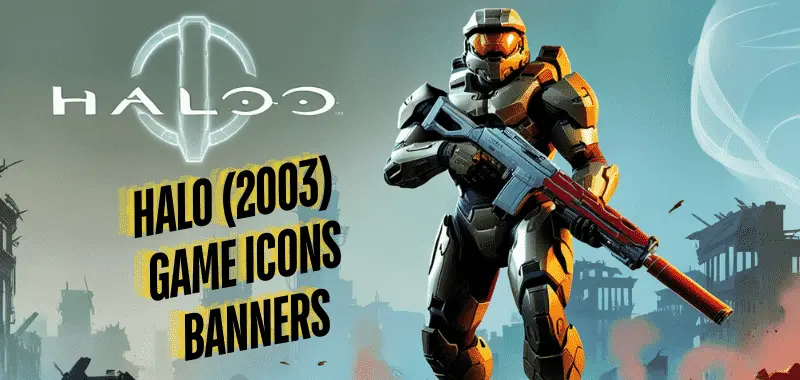
Halo (2003) Game Icons Banners: When “Halo: Combat Evolved” debuted in 2001, it no longer satisfactory set a new sizeable for first-character shooters but moreover added a sequence of game icons and banners that might emerge as mythical in the gaming network. These “Halo (2003) Game Icons Banners” had been extra than absolutely graphical factors; they served as a vital part of the game’s identity and an influential force in its branding method. This blog post explores the complicated global of Halo’s visual signatures, reading how these icons and banners had been meticulously crafted to mixture creative imaginative and prescient with sensible capability. We’ll discover the layers of layout that helped cement Halo’s place in gaming statistics and communicate how the visible factors keep to resonate with gamers around the arena.
Understanding Halo (2003) Game Icons Banners
What Are Game Icons?
Game icons are the small, visually attractive graphics that gamers first come across; they are crucial in setting the aesthetic and thematic tone of a game. In “Halo: Combat Evolved,” the icons used had been not just useful, but had been intricately designed to seize the essence of the sport’s sci-fi setting. These “Halo (2003) Game Icons Banners” carried out the picture of the Master Chief’s helmet, the Halo ring, and different thematic factors from the sport to create a short visual representation that became unique and memorable.
Significance of undertaking icons
Game icons function important visible representations of diverse in-game elements, along with guns, electricity-ups, and enemies. They provide gamers with immediate and intuitive information, considerably improving the overall gameplay experience. In the case of Halo (2003), the ones sport icons not exceptional fulfilled their sensible reason, but additionally played a critical function in setting up the sport’s extremely good aesthetic. The integration of those icons into the sport’s design contributed to its immersive sci-fi surroundings, allowing players to rapidly understand vital gadgets amidst the chaos of battle.
The Design Philosophy of Halo Icons
The icons in Halo (2003) have been meticulously designed to be each visually attractive and informative. Employing a minimalist method, the designers centered on simple shapes and bold colorings. This layout philosophy ensured that the icons stood out against the game’s complicated sci-fi backdrop, making them without problems recognizable even for the duration of extreme fight situations. The use of contrasting colors and clean shapes not only progressed usability but additionally contributed to the game’s iconic visible identity, influencing subsequent titles in the style.
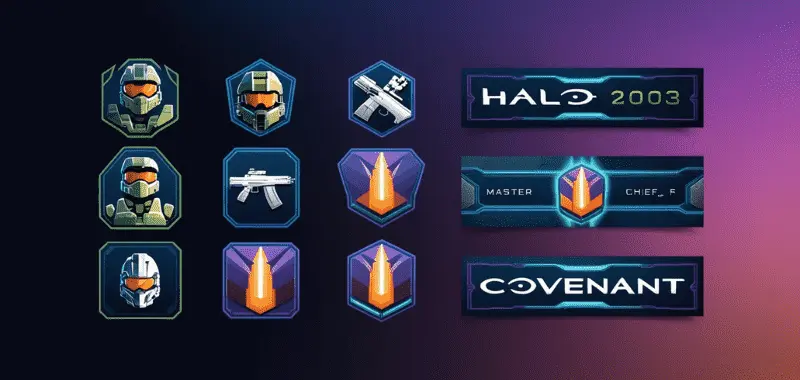
The Impact of Halo Icons on the Gaming Industry
The Halo Combat Evolved icons had a huge impact on the gaming enterprise, setting a brand new general for sport iconography. Their particular design and powerful use of visible language inspired many builders to undertake comparable layout principles. This led to a proliferation of visually striking and informative sport icons throughout diverse genres, improving participant engagement and experience. The fulfillment of Halo confirmed the significance of thoughtful layout in gameplay, influencing destiny titles to prioritize intuitive visual conversation in their interfaces. As a result, the legacy of Halo keeps to resonate in the gaming network, highlighting the long-lasting significance of effective iconography in video games.
Key Halo Game Icons and Their Meanings
The “Halo Combat Evolved” game, launched in 2003, brought a number of iconic game icons that have emerged as synonymous with the franchise. These icons now not only serve functional functions within the sport but moreover make a contribution to its particular visible identification. Below are a number of the important factor exercise icons and their meanings:
1. Energy Shield
The Energy Shield icon represents a protective barrier that absorbs incoming harm. This characteristic is crucial for game enthusiasts, because it complements survivability for the duration of extreme combat situations. The visible layout of the strength shield is characterized by means of a glowing, semi-apparent look, signifying its function as a short safety mechanism.
2. Fuel Rod Launcher
The Fuel Rod Launcher is depicted as an effective weapon able to fire explosive projectiles. This icon is often related to heavy firepower and is favored by players trying to deal sizable harm to enemies. Its layout typically features a sleek, futuristic look that aligns with the sport’s sci-fi aesthetic.
3. Needler
The Needler icon represents a fast-hearth weapon that shoots needle-like projectiles. Known for its exquisite purple color and unique firing mechanism, the Needler is a fan- favorite for its capacity to song dreams and deal damage through the years. The icon captures the weapon’s quirky layout, making it effortlessly recognizable.
4. Plasma Rifle
The Plasma Rifle is a versatile weapon that fires bolts of superheated plasma. It is represented through an icon that displays its smooth layout and capability. The Plasma Rifle is desired for its balance among fee of fireside and damage output, making it a staple in lots of gamers’ arsenals.five.
5. Shotgun
The Shotgun icon indicates a close-range weapon with excessive stopping power. Its format is easy, emphasizing its effectiveness in close-quarters combat. The Shotgun is essential for players who pick competitive methods and need a dependable weapon for taking down enemies up close.
6. Sniper Rifle
The Sniper Rifle icon represents an extended-range weapon recounted for its devastating accuracy. This icon is frequently associated with precision and ability, appealing to gamers who experience choosing off enemies from a distance. Its layout typically functions a scope, highlighting its characteristic as a marksman’s weapon.
What Are Game Banners?
Game banners feature appealing, visible representations of an game’s essence, appealing to game enthusiasts to find out and interact with the virtual world worldwide. In the case of Halo (2003), the Halo game banners no longer handiest captured the essence of the sport but additionally set it other than its contemporaries. The banners had been designed to be visually placed, straight away conveying the sport’s sci-fi putting and movement-packed gameplay.
The Design Philosophy of Halo Banners
The banners for Halo (2003) were crafted with an excellent and minimalist technique, specializing in key factors that could snatch the attention of capability game enthusiasts. The use of contrasting colors, together with the enduring blue and purple, created a sense of visible anxiety and excitement. The inclusion of the sport’s emblem and key characters, just like the Master Chief, set up a strong brand identity and allowed gamers to properly recognize the sport.
The designers of the Halo banners understood the importance of making a cohesive, visible language that might resonate with the sport’s intended marketplace. By incorporating factors from the game’s artwork style, together with the glossy and angular designs of the weapons and motors, the banners seamlessly integrated with the general aesthetic of the game.
Halo Banners and Player Engagement
Game banners serve as the first point of contact between a game and its potential players. In the case of Halo (2003), the banners were designed to spark curiosity and intrigue, enticing players to learn more about the game. The use of action-packed scenes, featuring the Master Chief in combat against the Covenant, conveyed the intensity and excitement of the gameplay.
The Halo banners were also strategically placed in high-traffic areas, such as gaming conventions and online platforms, ensuring maximum exposure to the target audience. This approach allowed the game to stand out among the countless other titles vying for players’ attention, ultimately driving increased engagement and sales.
The Legacy of Halo Banners
The success of Halo (2003) can be attributed, in part, to the impact of its game banners. The banners not only captured the essence of the game but also set a new standard for game marketing. The bold and minimalist design, combined with the use of iconic characters and elements, created a lasting impression on players and the gaming community as a whole.
The legacy of Halo banners continues to influence game marketing strategies today. Many developers have adopted similar design principles, creating banners that are visually striking and instantly recognizable. The success of the Halo franchise has also demonstrated the importance of maintaining a consistent visual identity across all marketing materials, from game banners to in-game assets.
MINECRAFT (2009) GAME ICONS BANNERS
The Art of Halo Game Banners
Designing Halo (2003) Icons
When developing your own “Custom Halo Icon Banner,” don’t forget the following hints:
- Use Iconic Elements: Incorporate well-known factors from the game, which include the Master Chief’s helmet, the Halo ring, or the Warthog car.
- Maintain Simplicity: Icons want to be clear and recognizable even in small sizes. Avoid overly complicated designs.
- Consistent Style: Ensure that your icons have a constant fashion. Whether you select a minimalist or precise technique, consistency is pinnacle.
- Tools for Icon Creation: Utilize photograph design software programs like Adobe Illustrator, Photoshop, or free gear like GIMP. There are also specific icon-making software applications, which include IconWorkshop or IcoFX.
Banner Design Ideas
To create an attention-grabbing “Halo (2003) Game Banner,” don’t forget the subsequent elements:
- Action Scenes: Seize the maximum explosive moments from the sport, for instance, battle fights or locations that may be already spent in the sport, as a means for growing enthusiasm.
- Character Focus: Be organized to have the maximum great characters featured, including the Master Chief, Cortana, and the Covenant enemies.
- In-Game Landscapes: Incorporate exercise environments just like the Halo ring and specific planets that can be considered futuristic.
- Text and Quotes: Using the sport’s emblem or costs can give a boost to the topic and maintain it in memory.
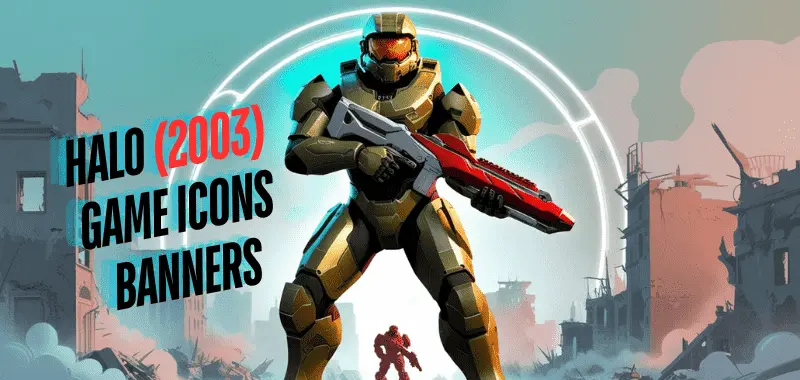
The Evolution of Halo’s Iconography
Over the years, the “Halo (2003) Game Icons Banners” have superior notably, adapting to new technology and artistic trends at the same time as retaining the middle factors that lovers love. The evolution of these icons shows a deeper shift in the sport’s seen storytelling, from the clean but bold designs of the early 2000s to the more precise and immoderate-definition icons applied in later installments. This development not only suggests a technical improvement but moreover mirrors the increasing lore and complexity of the Halo universe itself. Each new set of sport icons and banners is cautiously crafted to mirror the current state of the sport’s story and technological advancements, making sure that the gameplay itself is as immersive due to the fact that the gameplay itself.
The Technical Evolution of Game Icons and Banners
As technology was superior, so was the complexity and notableness of the “Halo (2003) Game Icon Banners.”. Initially, those factors were designed with constrained decisions due to the technical constraints of the time. However, as photograph layout equipment and display technology improved, the icons and banners have been up-to-date to take advantage of higher resolutions and, in addition, colorful color palettes.
This technical evolution allowed for added excellent and dynamic icons and banners, that could better bring the sport’s subjects and surroundings. The transition from clean pixel-primarily based designs to high-definition pictures marked a big milestone within the seen evolution of the Halo franchise.
The Significance of Halo’s Visual Identity
The seen identification mounted with the resource of the “Halo (2003) Game Icons Banners” has come to be a benchmark for other video games in the style. The combination of strong, recognizable icons with immersive banners created a cohesive revel in that better the general appeal of the game.
This method of design has brought on infinite distinct video games, proving that a nicely crafted identity can considerably make contributions to a recreation’s fulfillment. The lasting legacy of “Halo (2003) Game Icons Banners” may be seen in how future installments of the franchise have maintained and built upon the ones iconic factors.
GNHUSTGames: The Go-To Hub for Free Unblocked Games
Cultural Significance of Halo (2003) Game Icons Banners
The “Halo (2003) Game Icons Banners” have come to be emblematic inside the gaming community, transcending their preliminary function as mere in-recreation visuals. These factors, specifically the Master Chief’s helmet and the Halo ring, have grown into symbols diagnosed by both gamers and non-game enthusiasts alike.
They are often featured in fan paintings, merchandise, and even cosplay, showcasing their deep-rooted presence in famous lifestyles. Their enduring attraction highlights how Halo has no longer best fashioned the first-individual shooter fashion but additionally contributed to gaming’s broader cultural panorama.
Conclusion
The “Halo (2003) Game Icons Banners” no longer simplest outline the classy of one of the most influential video games in records but additionally beautify the gameplay experience by integrating artwork with application. As we have explored, the visible elements play a multifaceted function in player engagement, brand identification, and the overall success of the sport.
By knowing the standards on the lower back of these designs, both game enthusiasts and builders can admire the profound impact that nicely crafted game icons and banners can have on the gaming experience. The legacy of “Halo (2003) Game Icons Banners” keeps to encourage and have an effect on the gaming employer, proving that the strength of visible storytelling is as important as the gameplay itself.









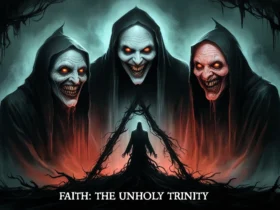
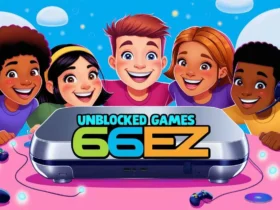

Leave a Review